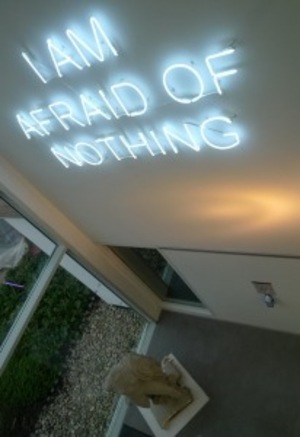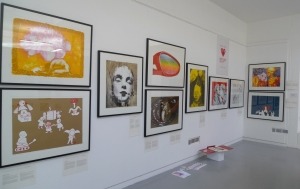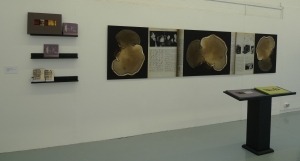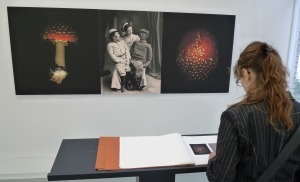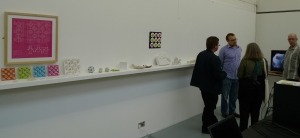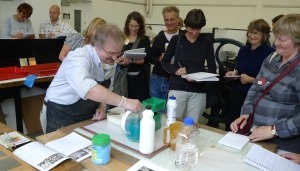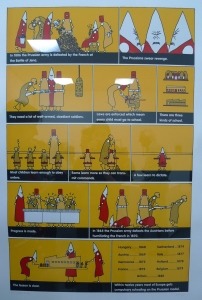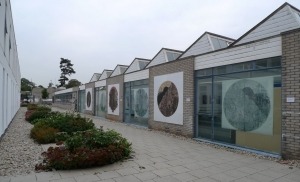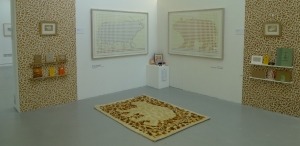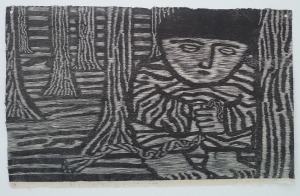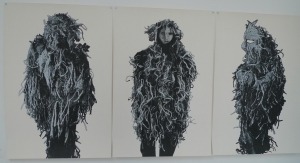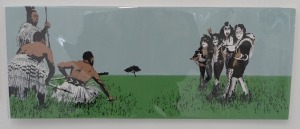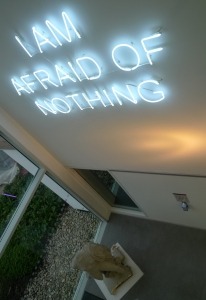DOTTED LINE OF CONTEMPORARY GRAPHIC ART IN LITHUANIA AND THE WORLD 0
(After returning from the conference “Impact 6” in Bristol)Greta Grendaitė
www.kamane.lt , 2009 10 20
In brief: Fingers of hands would be enough in order to calculate the more noticeable graphic events in Lithuania during the latter several years. The project of Baltic graphic art launched by the curators Jūratė Rekevičiūtė, Ignas Kazakevičius and their team in 2005 gained the shape of the international biennial in 2006–2008 and joined Vilnius, Kaunas Klaipėda as well as was presented abroad. At the initiative of the Lithuanian Artists’ Union the exhibition of Lithuanian graphic art and sculpture “Space. Plane. Body” was opened at the Contemporary Art Centre in 2006. In addition to prints created by various usual techniques, space graphic works and objects of hand-made paper were presented in it. In 2007 Marius M.Danys started the project of digital graphic art as a travelling exhibition and catalogue "Digital Graphic Art. 2007". He visited several Lithuanian and Polish towns with it; still, the project seems to be silent now.
The 6th international triennial of small graphic forms took place in Arka gallery in the same year. The competitive exhibition “Print” is opened in Vilnius graphic art centre gallery Kairė – Dešinė every year. Some major group and personal exhibitions of Lithuanian and foreign authors take place in this gallery every year as well: e.g., “Prints” of Ray Bartkus, “Pranciška” (2008) by Eglė Kuckaitė, etc. However, there were only a few more memorable one-man graphic exhibitions along with the aforementioned ones. Two of them, “Loud Influences” by Arūnas Gelūnas (2005) and “Between Hope and Reality” of Kaunas artist Rolandas Rimkūnas (2009), were presented at Akademija gallery of Vilnius Academy of Arts. It is also necessary to mention the conference “Graphic Art on the Crossroads of Contemporary Arts” coordinated by Ramutė Rachlevičiūtė that took place in Chodkevičiai Palace in 2008. The landmarks of Lithuanian graphic art were reviewed in this conference from the historical and actual present perspectives. Such events could be organised more often, and perhaps they could become international.
The text was started with the Lithuanian context purposefully. It was necessary in order to speak about the international conference “Impact 6” in Bristol (Great Britain) that encompasses graphic art of the world. The author of the article participated in it in the middle of September. She organised a one-man exhibition "Before the Outburst” along with the Norwegian artist Prof. Rita Marhaug and colleagues and students who represented the Graphic Department of the National Bergen Academy of Arts. The author represented the Lithuanian graphic world as well as Vilnius Academy of Arts in this case.
Exhibition of G. Grendaitė and R. Marhaug “Before the Outburst”
Another Lithuanian, Jūratė Kemeklytė-Bagdonienė, who recently finished Master studies of graphic art in Vilnius, came to the conference on her own. She presented a report about Lithuanian graphic art before the rise of the “iron curtain” based on the theoretical work defended by her. There were no other Lithuanians among almost four hundred participants of the conference this year. The author did not see any Latvian representatives. Meanwhile, Estonian graphics appeared to be the most active among the Baltic States and presented a mixed collection of contemporary prints.
Fragment from the Estonian collection of lithographs
The number of events during the concentrated period of the conference “Impact 6” surprised by the abundance and quality of content. The organisers stated that it was the most important event in the world dedicated to multi-disciplinary graphic art and related media. The conference takes place every two years. The question arises why it is worth participating in the conference? In the author's opinion, Lithuanian art and art education institutions could pay more attention to similar international forums and encourage artists as well as students, lecturers and researchers to participate in them. Such conferences are ideal for getting acquainted and exchanging information as well as ideas with colleagues, to view exhibitions, get to know the improved classical and newest technologies and experiments of print.
Exposition of the collection of E. Bateman “Mechanical Brides of the Uncanny”
Out of several exhibitions of “Impact”, the authors of which presented works performed in digital print technique, the author draws attention to two: the exhibition of the Finnish artist Anita Jensen, “Dreams of Order” and American artist Edward Bateman “Mechanical Brides of the Uncanny”. The works of these authors have much in common. The associative attitude of artists to things is felt first of all. Small-scale works of E.Bateman make one look at them from an intimate distance. The artist plays with confrontation of the past and future, meaning and meaningless.
Fragment from A.Jensen’s exhibition “Dreams of Order”
Fragment from A.Jensen’s exhibition “Dreams of Order”
Meanwhile, A.Jensen creates unexpected links among existing objects in photographs and specifically purified things. She uses high-quality pigmental digital print for this and obtains almost shining objects in the background of opaque blackness.
Presentation of 3D design and realisation of objects
Having in mind the endless possibilities of digital print, it is not hard to perceive the paradox in their relation with all contemporary shapes of graphic arts. Classic techniques of prints related closely with hand work seem to be reborn anew and flourish along with the new technologies. For instance, the process of objects growing by layers according to a computer project was demonstrated in practical trainings; still, masters of hand-made intaglio printing techniques as well as wood carving, lithography, serigraphy received the most of attention.
A.Bytautas. Practical demonstration of techniques
The usual digital print and creation of a view on a computer screen really causes the lack of more diverse feelings. One of such feelings is touching. Therefore, it is evident that digital technologies are not powerful enough to push out the live drawing from the stage of contemporary art that enables the viewer to recognise the authentic stroke of an artist’s pencil, pen or line in ink. This was perfectly illustrated by the international exhibition of contemporary drawing “The End of the Line. Attitudes in Drawing” presented in Bristol City Museum and Art Gallery, in which such famous artists as Michaël Borremans, Kim Hiorthøy, Fernando Bryce were introduced.
N.Morley aqua fortis “Rhino Girl”
Ch.McCail serigraphy “Compulsory Education”
A really well prepared exhibition “Open Print. 2009” was presented in the Royal West England Academy. The aim of it was to reveal the evolution of print in a concentrated manner. It was possible to get acquainted with small graphic forms from all over the world, i.e. with miniatures, ex-librises, individual prints, in the exhibition “The Undergrowth of Printmaking” at Off-Centre Gallery.
Buildings of West England University, Graphic Art Research Centre from the outside
Exhibition of D.Faithfull “Incubator”
The main space of “Impact 6”, the Graphic Art Research Centre “Bower Ashton Campus” of West England University (where the author presented her exhibition) invited to the biggest exposition of collections and personal exhibitions. The graphic installation “Incubator” and books of a Scottish artist David Faithfull was presented in the neighbourhood of the author’s exhibition. The mixed exhibition of prints “Manu Propria” collected by the Estonian Graphics' Association as well as cycles of lithographs “Love in the 21st Century”, “Modern Graphic Art from Estonia” were introduced nearby as well. It was possible to see collections of contemporary graphic art even from Australia (“Stories of Our Making”) and New Zealand (“Another New Zealand”) in other halls.
Collection of Australian graphic art. Michael Schlitz wood carving “Boy with a Bitter End”
Collection of Australian graphic art. Neil Emmerson serigraphy “Wood Nymph Triptych (The Heart is a Lonely Hunter)”
Fragment of collection of New Zealand graphic art
Culture differences, cooperation on the creative basis, art of books, theoretical questions of print identity and its multi-disciplinary features, graphic communication in digital space will be emphasised in the coming conference “Impact 7”, which will take place at Monash University in Melbourne in 2011. Bristol handed over the right to organise this event to the Art and Design Faculty of Monash University. Artists, curators, print centres and studios, professors and students, graphic researchers, collectors and everybody interested in graphic art are expected in the event.
Fragment of the Graphic Art Research Centre from the inside








